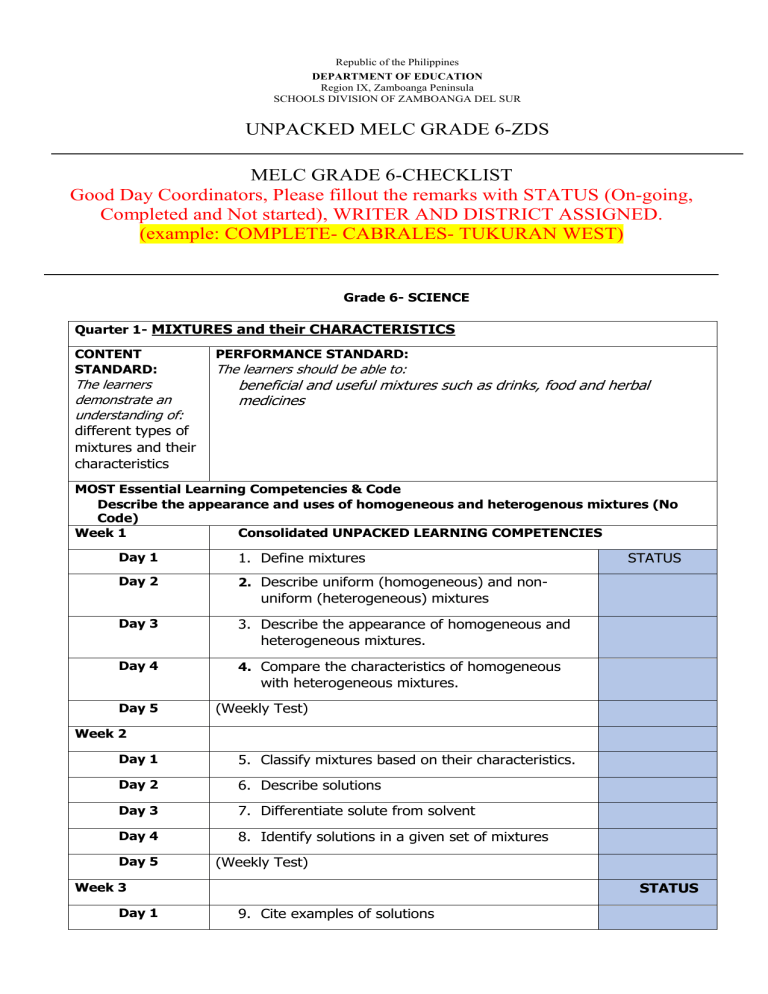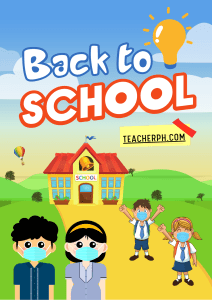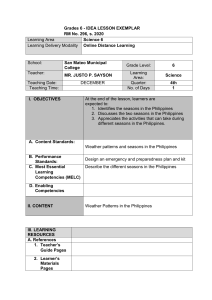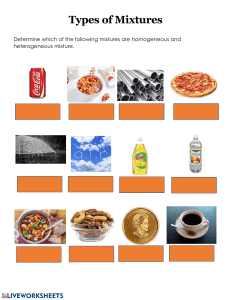Grade 6 Science Checklist: Mixtures, Body Systems, Ecosystems
advertisement

Republic of the Philippines DEPARTMENT OF EDUCATION Region IX, Zamboanga Peninsula SCHOOLS DIVISION OF ZAMBOANGA DEL SUR UNPACKED MELC GRADE 6-ZDS MELC GRADE 6-CHECKLIST Good Day Coordinators, Please fillout the remarks with STATUS (On-going, Completed and Not started), WRITER AND DISTRICT ASSIGNED. (example: COMPLETE- CABRALES- TUKURAN WEST) Grade 6- SCIENCE Quarter 1- MIXTURES and their CHARACTERISTICS CONTENT STANDARD: The learners demonstrate an understanding of: different types of mixtures and their characteristics PERFORMANCE STANDARD: The learners should be able to: beneficial and useful mixtures such as drinks, food and herbal medicines MOST Essential Learning Competencies & Code Describe the appearance and uses of homogeneous and heterogenous mixtures (No Code) Week 1 Consolidated UNPACKED LEARNING COMPETENCIES Day 1 1. Define mixtures Day 2 2. Describe uniform (homogeneous) and non- STATUS uniform (heterogeneous) mixtures Day 3 3. Describe the appearance of homogeneous and heterogeneous mixtures. Day 4 4. Compare the characteristics of homogeneous with heterogeneous mixtures. Day 5 (Weekly Test) Week 2 Day 1 5. Classify mixtures based on their characteristics. Day 2 6. Describe solutions Day 3 7. Differentiate solute from solvent Day 4 8. Identify solutions in a given set of mixtures Day 5 (Weekly Test) Week 3 Day 1 STATUS 9. Cite examples of solutions Day 2 Day 3 Day 4 Day 5 10. Describe the appearance of suspensions and colloids. 11. Classify mixtures based on their characteristics 12. Tell the uses of homogeneous and heterogeneous mixtures. 13. Make a chart classifying mixtures into uniform and non-uniform using pictures. Good Day Coordinators, Please fillout the remarks with STATUS (On-going, Completed and Not started), WRITER AND DISTRICT ASSIGNED. (example: COMPLETE- CABRALES- TUKURAN WEST) QUARTER 2 – LIVING THINGS AND ENVIRONMENT I. PARTS AND FUNCTIONS II. Human Body Systems CONTENT STANDARDS PERFORMANCE STANDARDS The learner demonstrate The learner should be able to make a chart understanding of how the major organs showing healthful habits that promote proper of the human body work together to function of the musculo-skeletal,integumentary, form organ system. digestive, and nervous systems. LEARNING COMPETENCIES a. Explain how the organs of each system work together ( S6LT-IIa-b) Explain how the different organ systems work together (S6LT-IIc-d-2) WEEK 1 STATUS 1.Identify the major organs of musculo-skeletal system 2.Give the functions of the major organs (K) 3.Explain how the muscles and bones support each other for movement (U) 4. Identify the major organs of the integumentary system (K) 5. Give the functions of the major organs (K) 6. Explain how the skin and nails protect the body from injury (U) WEEK 2 STATUS 7. Identify the major organs of the digestive and circulatory system 8.9. Explain how the nutrients are distributed to the different parts of the body (U) 10. Identify the major organs of the respiratory system (K) 11. Give the functions of the major organs of the respiratory system (K) 12. Trace the flow of oxygenated blood in the respiratory system (U) WEEK 3 STATUS 13. Identify the major organs of the nervous system (K) 14. Give the functions of the major organs of the nervous system (U) 15. Trace the path of the message in the nervous system (U) 16.Make a graphic organizer showing the different major organ systems and the General function of each organ systems (D) 2. Animals 2.1 Vertebrates and Invertebrates CONTENT STANDARDS PERFORMANCE STANDARDS 1.make an inventory of vertebrates and invertebrates The learner demonstrate understanding of the that are commonly seen in the community. different characteristics of vertebrates and 2.practice ways of caring and protecting animals invertebrates LEARNING COMPETENCY b. Determine the distinguishing characteristics of vertebrates and invertebrates (S6LT-IIe-f-3) WEEK 4 ) STATUS 18. Describe general characteristics of vertebrates and invertebrates. (K) 19. Determine the distinguishing characteristics of the following invertebrates : sponges, annelids ,echinoderms , mollusk and arthropods .(U) 20. Classify invertebrates based from their distinguishing characteristics. ( U ) 21. Determine the distinguishing characteristics of the following vertebrates : fish , birds , mammals , amphibians , reptiles . ( WEEK 5) STATUS 22. Classify vertebrates based from their distinguishing characteristics . ( U ) 23. Identify the habitats of vertebrates and invertebrates. (K) 24. Make a scrapbook of different animals under vertebrates and invertebrates.(D) 3.Plants 3.1 Reproduction of Non-Flowering Plants CONTENT STANDARDS PERFORMANCE STANDARDS The learner demonstrate understanding how non- 1.Make a multi-media presentation on how flowering plants reproduce parts of the reproduction system of sporebearing and cone-bearing plants ensure their survivals 2. Make a flyer on how plants can be propagated vegetatively. LEARNING COMPETENCY Distinguish how spore-bearing and cone-bearing plants reproduce(S6MT-IIg-h-4) ( WEEK 6) 25. Give the general descriptions of spore-bearing plants and cone-bearing plants. (K) Give examples of spore-bearing and cone-bearing plants . ( K ) STATUS 26. Distinguish the distinct characteristics of spore-bearing and conebearing plants (U) 27. Compare the characteristics of spore-bearing and cone-bearing plants . ( U) 28. Distinguish how spore-bearing and cone –bearing plants reproduce. ( U ) 29. Make a synopsis on the concepts they have learned about spore-bearing and cone-bearing plants with pictures . ( D ) II.ECOSYSTEM 1. Interactions Among Living Things 2. Tropical rainforest 2.1 Coral reefs 2.2 Mangrove swamps CONTENT STANDARDS The learner demonstrate understanding the interactions for survival among living and nonliving things that take place in tropical rainforest, coral reefs, and mangrove swamps. LEARNING COMPETENCY PERFORMANCE STANDARDS Form discussion groups to tackle issues involving protection and conservation of ecosystem that serve as nurseries, breeding places, and habitats for economically important plants and animals c. Discuss the interactions among living things and non-living things in tropical Rain forest, coral reefs and mangrove swamps (S6LT-IIi-j-5) d. Explain the need to protect and conserve tropical rainforests, coral reefs and mangrove swamps (S6LT-IIi-j-6) WEEK 7 STATUS 30. Describe an ecosystem using the biotic ( living ) and abiotic (nonliving ) components. ( K ) 31. Identify the abiotic and biotic components in an ecosystem like a) tropical rain forest , b) coral reefs , and c) mangrove swamps ( K ) 32. Explain how the abiotic components such as air, water, sunlight , soil , and minerals interact with the biotic components in the tropical rain forest, coral reefs, and mangrove swamps ecosystems for survival . ( U ) WEEK 8 33. Identify some conditions where the balance in three ecosystems is disturbed . (U) STATUS 34. Identify ways to protect and conserve the a) tropical rainforests , b) coral reefs, and c) mangrove swamps ( U ) 35. Explain the importance of protecting and conserving the a) tropical rainforests , b) coral reefs , and c) mangrove swamps. ( U ) 36. Develop campaign posters that show how certain events and activities disturb the interrelationship in an ecosystem such as a) climate change b) natural calamities c) overpopulation, d) destructive practices (e.g. illegal logging, kaingin system, quarrying) ( D) Good Day Coordinators, Please fillout the remarks with STATUS (On-going, Completed and Not started), WRITER AND DISTRICT ASSIGNED. (example: COMPLETE- CABRALES- TUKURAN WEST) Quarter 3 – FORCES, MOTION & ENERGY Content : Gravitation and Frictional Forces Content standard: The learners demonstrate understanding of gravity and friction that affect movement of objects. Performance standard: The learners should be able to produce an advertisement that demonstrate road safety. Learning competency a. Infer how friction and gravity affect movement of different objects. (S6FE-IIIa-c-1) WEEK 1 1. Define gravity; (K) 2. Describe the effect of gravity on an object; (U) 3. Identify conditions where the effect of gravity is greater. (U) STATUS 4. Infer how gravity affects the movement of objects (U ) WEEK 2 STATUS 5. Describe friction; (K) 6. Explain the effect of friction on the motion of objects; (U) 7. Infer how friction affects movement of different objects ( U ) 8. Identify factors that affect the movement of the objects based on the given situation; (U) 9. Crate situations that show effect of gravity on objects ( D ) Content: Energy transformation in simple machines PERFORMANCE STANDARD: The learners should be able to The learners demonstrate understanding of how energy is transformed in create a marketing strategy simple machines. for a new product on electricity or light efficiency. Content standard: Learning competency Demonstrate how sound, heat, light and electricity can be transformed. (S6FE-IIId-f-2) WEEK 3 10. Identify forms of energy (K) 10.1 sound 10.2 heat 10.3 light 10.4 Electricity WEEK 4 11. 12. 13. 14. STATUS Describe how sound energy is formed and used; (U) Demonstrate how sound energy is transformed; (D) Describe how heat energy is formed and used; (U) Demonstrate how heat energy is transformed; (D) WEEK 5 15. 16. 17. 18. STATUS STATUS Describe how light energy is formed and used; (U) Demonstrate how light energy is transformed; (D) Describe how electrical energy is formed and used; (U) Demonstrate how electrical energy is transformed; (D) Learning competency : Manipulate simple machines to describe their characteristics and uses. (S6FE-IIIg-i-3) STATUS WEEK 6 19. Describe a simple machine. (SUMMARY) 20. Describe the characteristics of lever. ( k) Explain the use/uses of levers (U) Manipulate simple levers . (d) 21. Describe the characteristics of pulleys . (k) Explain the use of pulleys .(u) Manipulate simple pulleys ( D) 22. Describe the characteristics of wheel and axle. (k) Identify machines with wheel and axle. (k) 23. Explain the use/uses of wheel and axle (u) Manipulate wheel and axle machines. (d) STATUS WEEK 7 30. Describe the characteristics of the screw. (u) Explain the use/uses of screws (u) 31. Manipulate simple screws.(d) Describe the characteristics of an inclined plane. (k) 31. Explain how an inclined plane makes work easier. (u) Manipulate inclined planes . (d) 32. Describe the characteristics of wedges. (k) Differentiate the two kinds of wedges. (k) 33. Explain the use/uses of wedges. (u) Manipulate simple wedges. (d) Learning Competency : Demonstrate the practical and safe uses of simple machines. (S6FE-IIIj-4) STATUS WEEK 8 40. Discuss safety tips in using and storage of the different types of simple machines. (k). 41. Suggest ways of proper handling of simple machines. (u) 42. Demonstrate practical and safe uses of simple machines. (d) Good Day Coordinators, Please fillout the remarks with STATUS (On-going, Completed and Not started), WRITER AND DISTRICT ASSIGNED. (example: COMPLETE- CABRALES- TUKURAN WEST) GRADE 6 QUARTER 4- Earth and Space CONTENT 1. Forces that affect changes on the earth’s surface 1.1 Earthquake 1.2 Volcanic Eruption CONTENT STANDARD The learners demonstrate understanding of… the effects of earthquakes and volcanic eruptions PERFORMANCE STANDARD The learners should … Design an emergency and preparedness plan and kit Learning Competency a. Describe the changes on the Earth’s Surface as a Result of Earthquakes and Volcanic Eruptions (S6ES-Iva-1) ( WEEK 1 ) 1. Describe the characteristics of the earth’s surface`(K) 2. Differentiate tectonic earthquake from volcanic earthquake.(U) 3. Describe the changes on the earth’s surface as a result of earthquakes.(U) 4. Describe the changes on the earth’s surface as a result of volcanic eruption.(U) CONTENT Forces that affect changes on the earth’s surface 1. Forces that affect changes on the earth’s surface 1.1 Earthquake 1.2 Volcanic Eruption CONTENT STANDARD The learners demonstrate understanding of… STATUS PERFORMANCE STANDARD the effects of earthquakes and volcanic eruptions Learning Competency Enumerate what to do before, during and after an earthquake and volcanic eruptions (S6ES-IVb-2) WEEK 2 STATUS 5. Enumerate precautionary measures before, during and after an earthquake. (K) 6. Enumerate precautionary measures before, during and after volcanic eruptions. (K) 7. Design an emergency and preparedness plan. (D) CONTENT 2. Weather Patterns in the Philippines 2.1 Weather patterns and Seasons in the Philippines CONTENT STANDARD The learners demonstrate understanding of… PERFORMANCE STANDARD weather patterns and seasons in the Philippines Learning Competency c. Describe the different seasons in the Philippines (S6ES-IVc-3) WEEK 3.1 STATUS 8. Identify the different seasons in the Philippines. (K) Identify places in the Philippines that experience different type of seasons/climate. (K) 9. Describe the two seasons in the Philippines. (U) Explain the factors that affect the seasons/climate in the Philippines.(U) CONTENT 2. Weather Patterns in the Philippines 2.1 Weather patterns and Seasons in the Philippines CONTENT STANDARD The learners demonstrate understanding of… PERFORMANCE STANDARD weather patterns and seasons in the Philippines Learning Competency d. Discuss appropriate activities for specific seasons of the Philippines (S6ES-IVd-4) WEEK 3.2 STATUS 10. 1 Identify the appropriate activities for specific seasons of the Philippines. (K) 10.2 Discuss the appropriate activities for specific seasons of the Philippines.(U) 11. 1 Suggest appropriate activities during wet and dry seasons that can be done by family and community (U) 11.2 Perform activities/games/tasks that is appropriate for dry /wet season.(D) CONTENT 3. Motions of the Earth 3.1 Rotation and Revolution CONTENT STANDARD PERFORMANCE The learners demonstrate understanding of… STANDARD the earth’s rotation and revolution Learning Competency e. Demonstrate rotation and revolution of the Earth using a globe to explain day and night and the sequence of seasons (S6ES-IVe-f-5) WEEK 4 12. Describe how earth rotates on its axis. (K) 13. Explain what causes day and night.(U) 14. Demonstrate rotation of the Earth using a globe to explain day and night .(D) 15.Demonstrate how the earth revolves around the sun. (D) WEEK 5 16. Describe the 4 seasons in other countries. (K) 17. Explain the factors that influence the 4 seasons.(U) STATUS STATUS 18. Demonstrate revolution of the Earth using a globe to explain the sequence of seasons.(D) CONTENT 4. The Solar System 4.1 Planets CONTENT STANDARD The learners demonstrate understanding of… PERFORMANCE STANDARD characteristics of planets in the solar system Learning Competency f. Compare the planets of the solar system (S6ES-IVg-h-6) WEEK 6 STATUS 19. Describe the characteristics of inner planets.( Mercury, Venus, Earth, Mars) (K) 20. Describe the characteristics of outer planets.(Saturn, Jupiter, Uranus, Neptune) (K) 21. Compare the relative sizes and composition of the inner and outer planets.(U) 22. Compare the relative distances of each planets. (U) 23. Compare the distinct characteristics of planets in the solar system.(U) No. of satellites No. of rings Surface temperature Mass Density Atmosphere Rotation CONTENT 4. The Solar System 4.1 Planets CONTENT STANDARD The learners demonstrate understanding of… characteristics of planets in the solar system PERFORMANCE STANDARD Learning Competency g. Construct a model of the solar system showing the relative sizes of the planets and their relative distances from the Sun. (S6ES-IVi-j-7) Unpacked Learning Competencies (WEEK 7) 24. Describe the relative sizes of the planets of the solar system. ( U ) 25. Describe the relative distances of the planets of the solar system. ( U ) 26.Construct/improvised a model of the solar system showing the relative sizes of the planets and their relative distance from the sun. (D) STATUS




